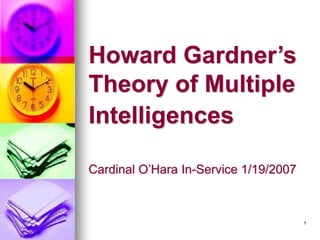
multiple intelligences
- 1. 1 Howard Gardner’s Theory of Multiple Intelligences Cardinal O’Hara In-Service 1/19/2007
- 2. 2 Definition of Intelligence Human intelligence has the following characteristics: o A set of skills that enable a person to resolve genuine problems encountered in life. o The ability to create an effective product or offer a service that is valued in a culture. o The potential for recognizing or creating problems, thereby establishing the necessity for the new knowledge.
- 3. 3 Principles of Multiple Intelligence Theory 1. Intelligence is not singular: intelligences are multiple. 2. Every person is a unique blend of dynamic intelligences.
- 4. 4 Principles of Multiple Intelligence Theory 3. Intelligences vary in development, both within and among individuals. 4. All intelligences are dynamic.
- 5. 5 Principles of Multiple Intelligence Theory 5. Multiple intelligences can be identified and described. 6. Every person deserves opportunities to recognize and develop the multiplicity of intelligences.
- 6. 6 Principles of Multiple Intelligence Theory 7. The use of one of the intelligences can be used to enhance another intelligence. 8. Personal background density and dispersion are critical to knowledge, beliefs, and skills in all intelligences.
- 7. 7 Linguistic Intelligence Linguistic intelligence (or verbal- linguistic) is the ability to use with clarity the core operations of language. People with highly developed linguistic intelligence are sensitive to the meaning of words. They have the capacity to follow rules of grammar, and, on carefully selected occasions, to violate them with good effect.
- 8. 8 At a somewhat more sensory level, linguistic intelligence is a sensitivity to the sounds, rhythms, inflections, and meters of words-- the ability which can make even poetry in a foreign tongue beautiful to hear. Linguistic intelligence is also a sensitivity to the different functions of language--its potential to excite, convince, stimulate, convey information, or simply to please.
- 9. 9 People who exhibit developed linguistic intelligence include: Poets Authors Reporters Speakers Attorneys Talk-show hosts • Politicians • Teachers • Lecturers
- 10. 10 Logical-Mathematical Intelligence Logical-Mathematical intelligence is logical and mathematical ability as well as scientific ability. Abstraction is fundamental, reasoning is complex, and problem-solution is natural. Order and sequence are significant. There is a drive to know causality as well as the explication of existence.
- 11. 11 People who exhibit developed logical-mathematical intelligence include: Mathematicians Engineers Physicists Researchers Astronomers Scientists
- 12. 12 Naturalistic Intelligence Naturalistic intelligence is the ability to understand, relate to, categorize, classify, comprehend, and explain the things encountered in the world of nature.
- 13. 13 People who exhibit developed naturalistic intelligence include: Farmers Ranchers Hunters Gardeners Animal handlers Botanists Geologists
- 14. 14 Musical (Musical-rhythmic) Intelligence Musical intelligence (or Musical- rhythmic) is the ability to use the core set of musical elements-- pitch, rhythm, and timbre (understanding the characteristic qualities of a tone). There may be a hierarchy of difficulty involved in various roles, e.g., listening performance composition.
- 15. 15 People who exhibit developed musical intelligence include: Singers Composers Instrumentalists Conductors People who enjoy, understand, use, create, perform, and appreciate music and/or elements of music
- 16. 16 (Visual-)Spatial Intelligence Spatial intelligence (or visual- spatial) is the capacity to perceive the world accurately, and to be able to recreate one's visual experience. A person with a good sense of direction or the ability to move and operate well in the world would indicate spatial intelligence.
- 17. 17 Visual-spatial intelligence entails a number of loosely related capacities, such as: the ability to recognize instances of the same element the ability to recognize transformations of one element in another the capacity to conjure up mental imagery and then to transform that imagery the ability to produce a graphic likeness of spatial information
- 18. 18 People who exhibit developed spatial intelligence include: Sailors Engineers Surgeons Sculptors Painters Cartographers Architects
- 19. 19 Bodily-Kinesthetic Intelligence Bodily-Kinesthetic intelligence is control of one's bodily motions and the ability to handle objects skillfully.
- 20. 20 People who exhibit developed bodily-kinesthetic intelligence include: Actors Dancers Swimmers Acrobats Athletes Jugglers Instrumentalists Artisans
- 21. 21 Inter-Personal Intelligence Inter-personal intelligence is the ability to notice and make distinctions among other individuals and, in particular, among their moods, temperaments, motivations, and intentions.
- 22. 22 People who exhibit developed inter-personal intelligence include: Politicians Religious leaders Counselors People in the helping professions
- 23. 23 Intra-Personal Intelligence Intra-Personal intelligence is the ability to form an accurate model of oneself, and to use that model to operate effectively in life.
- 24. 24 People who exhibit developed intra-personal intelligence include: Novelists Therapists Sages Psychologists Philosophers
- 25. 25 Existential Intelligence Existential Intelligence is sensitivity and capacity to tackle deep questions about human existence.
- 26. 26 People who exhibit developed existential intelligence include: Theologians Philosophers Spiritual advisors
- 27. 27 Intelligences Being Examined Spiritual Intelligence Moral Intelligence
- 28. 28 Curricular Implications All intelligences are needed to function in society Educators need to reach out to a broader range of skills and talents A deeper understanding of curriculum takes place when more intelligences are incorporated Can we facilitate interconnections between/among intelligences?
- 29. 29 Incorporate the Theory Allowing opportunities for assessment that allows students to use their stronger intelligences can be an indicator of their grasp of the material
- 30. 30 Incorporate the Theory Portfolios, independent projects, journals, and other creative projects allows for student choice and therefore interest in creating. Material learned and applied in an authentic situation may have greater learning impact.
